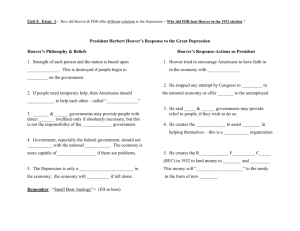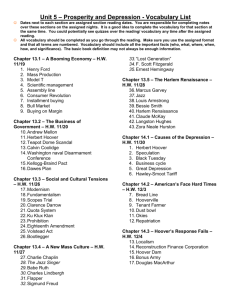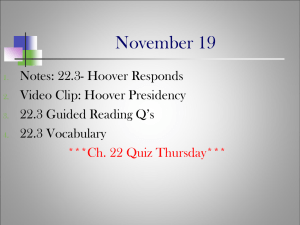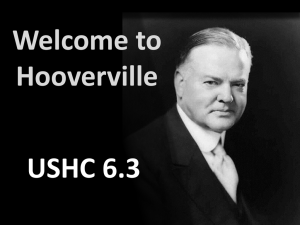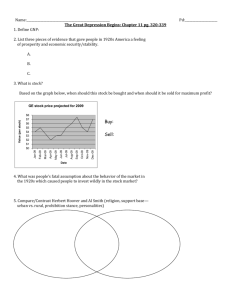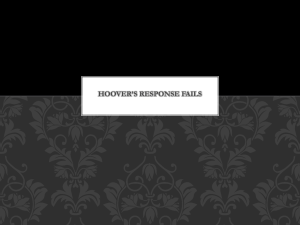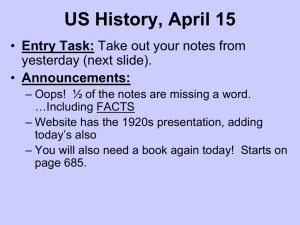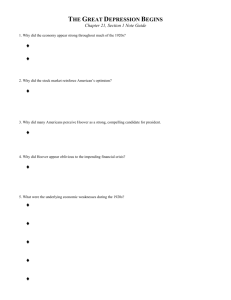Chapter 21 Section 3 Hoover's Response Fails
advertisement
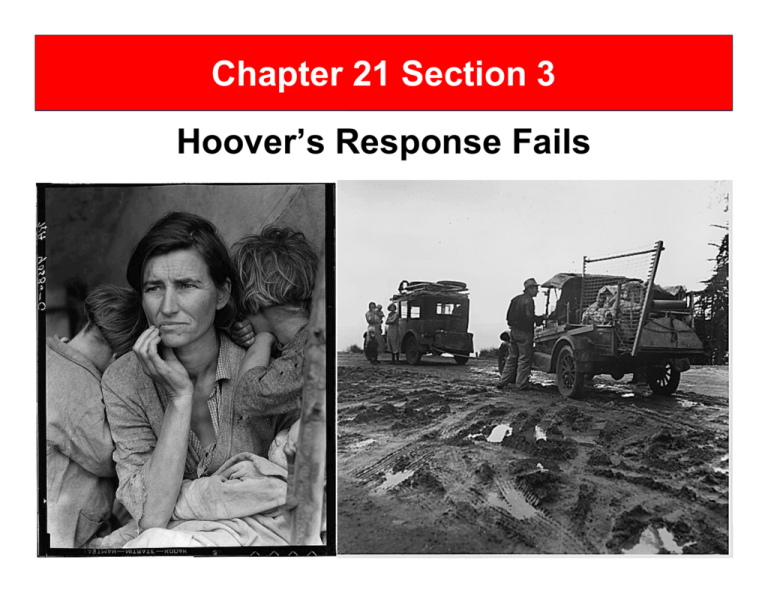
Chapter 3 Section 25 Section 1 Chapter 21 Section 3 Hoover’s Response Fails The ColdHoover’s War Begins Response Fails Chapter 3 Section 25 Section 1 Focus Question Why did Herbert Hoover’s policies fail to solve the country’s economic crisis? As the Great Depression spread misery across America, Herbert Hoover struggled unsuccessfully to respond to the nation’s problems. As a result of Hoover’s failed response, in 1932 Americans would turn to a new leader and increased government intervention to stop the depression. The ColdHoover’s War Begins Response Fails Chapter 3 Section 25 Section 1 At the start of the economic downturn, Hoover took a hands-off approach. Hands-Off Hoover Like most economists of the day, he believed that up and down swings in the economy were a natural part of the business cycle. It was thought that strong businesses would weather storms without the support of the government. The ColdHoover’s War Begins Response Fails Chapter 3 Section 25 Section 1 Hoover’s Volunteerism Hoover saw that he must do something: Asked businesses to keep wages, employment, and prices at current levels Called for tax cuts, lower interest rates, and public works The ColdHoover’s War Begins Response Fails Asked wealthy to donate more money to charity Chapter 3 Section 25 Section 1 Volunteerism Fails But volunteerism failed: Hoover put his faith in localism, a policy whereby problems are best solved at the local and state levels. • Towns and states didn’t have the necessary resources to deal with the depression. • Hoover did not support direct federal aid to individuals. The ColdHoover’s War Begins Response Fails Chapter 3 Section 25 Section 1 Trickle Down Economics In 1932, Hoover urged Congress to create the Reconstruction Finance Corporation (RFC). The RFC employed a policy known as trickle down economics. The RFC gave billions of dollars to banks and large businesses. The idea was that they would lend to, and invest in, struggling businesses who would hire workers and thus end the depression. The RFC failed when businesses did not hire more workers. The ColdHoover’s War Begins Response Fails Chapter 3 Section 25 Section 1 The Hoover Dam One policy that did succeed was the construction of Boulder Dam (later renamed Hoover Dam) across the Colorado River. Started in 1930, the huge dam provided power for millions and irrigation for farm land, and put thousands to work. The ColdHoover’s War Begins Response Fails Chapter 3 Section 25 Section 1 The ColdHoover’s War Begins Response Fails Chapter 3 Section 25 Section 1 The ColdHoover’s War Begins Response Fails Chapter 3 Section 25 Section 1 The Bonus Army Many grew disillusioned during the Great Depression. • Some blamed Hoover and some blamed capitalism. • Some were World War I veterans who wanted a bonus that was promised to them. • In 1932, those veterans formed the Bonus Army and marched on Washington. The ColdHoover’s War Begins Response Fails Chapter 3 Section 25 Section 1 The ColdHoover’s War Begins Response Fails Chapter 3 Section 25 Section 1 The Bonus Army 20,000 veterans set up camps and occupied vacant buildings. In July, police tried to evict them and riots erupted. Hoover ordered General Douglas MacArthur to remove the veterans. He used tear gas, cavalry, tanks, and troops with fixed bayonets. Press photos of troops using excessive force angered the American public. The ColdHoover’s War Begins Response Fails Chapter 3 Section 25 Section 1 The ColdHoover’s War Begins Response Fails Chapter 3 Section 25 Section 1 A New Leader? The eviction of the Bonus Army doomed Hoover’s bid for re-election. Americans were ready for new leadership and a greater role for the government in solving problems. The ColdHoover’s War Begins Response Fails Chapter 3 Section 25 Section 1 The ColdHoover’s War Begins Response Fails
